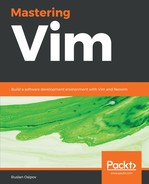In this chapter, you learned (or got a refresher on) how to use Git, including a quick brush-up on core concepts and setting up and cloning existing projects, and a rundown of the most frequent commands. You learned about vim-fugitive, a Vim plugin that makes Git a lot more interactive from inside Vim.
We covered vimdiff, a separate tool packaged with Vim made for comparing files and moving changes between files. We learned how to compare and move changes between multiple files. Furthermore, we got some practice at resolving nasty Git merge conflicts, which will hopefully make them less intimidating.
This chapter covered multiple ways of running shell commands when working with Vim, be it through tmux, screen, or Vim terminal mode
We also learned about (global) quickfix and (local) location lists, which can be used to store pointers to certain lines in files. We combined those with the output of :grep and :make commands to get some easy-to-navigate results! We learned how :make works to call an external compiler, and covered the vim-dispatch plugin to expand the :make functionality, and the vim-test plugin to make running tests smoother.
Lastly, we covered a set of solutions for running syntax checkers in Vim, including building our own solution for Pylint. We've looked at ALE, an asynchronous linter, and Syntastic, a similarly popular syntax checker.
In the next chapter, we will cover refactoring operations using Vim regular expressions and macros.
